How To Make Your Own Film Camera
Don't call it a comeback: film is experiencing a resurgence. The industry that died almost overnight in the tardily 90's is roaring back, with vintage lenses popping up on eBay and 35mm film prices increasing weekly on Amazon.
There's but something near analog photography that is more engaging — more personal — than digital.
Only just recently did I decide that I wanted to first shooting picture; correct after that I realized I had no thought where to start. I wrote this article to depict some of my own experiences and hopefully save y'all some fourth dimension if you notice yourself heading down a similar path.
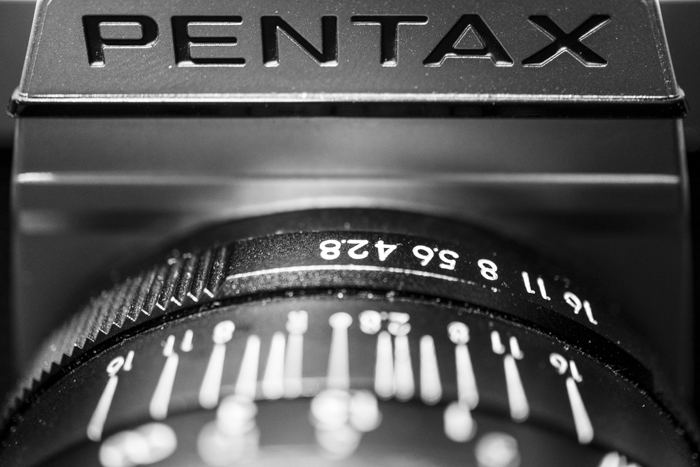
I institute that if you're thinking almost shooting with moving-picture show, there are actually only a few things you demand, and yous can do it without breaking the bank!
A Film Camera Body
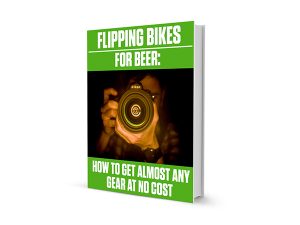 I started doing some inquiry, and realized that it's possible to score some seriously cool cameras on eBay, Amazon, or Craigslist. Many times, these are attic/basement finds and are in near mint-status.
I started doing some inquiry, and realized that it's possible to score some seriously cool cameras on eBay, Amazon, or Craigslist. Many times, these are attic/basement finds and are in near mint-status.
Often, the seller isn't really sure what they have and just want to flip it for some quick greenbacks.
[Mike here: if you desire to learn how to buy gear for super inexpensive and even sell it later at a profit, check out my ebook 'Flipping Bikes for Beer' (you'll get the championship when yous read it) that is included in my eBook collection.In that location is no style this doesn't work out well for you: if the seller is a "camera person," then you lot're likely getting a fair toll for an item in good condition. If they aren't, you're getting an astonishing deal on a nice piece of vintage equipment, or something you can flip for parts/repairs for close to the price you paid.
You can read up on specific models, years of production, and things to await for or avoid on CameraPedia.
Eventually, I settled on a Pentax K1000 as my offset film camera. I paid a little more than $80 on Amazon for the body and a 50mm lens (the ubiquitous "nifty l").
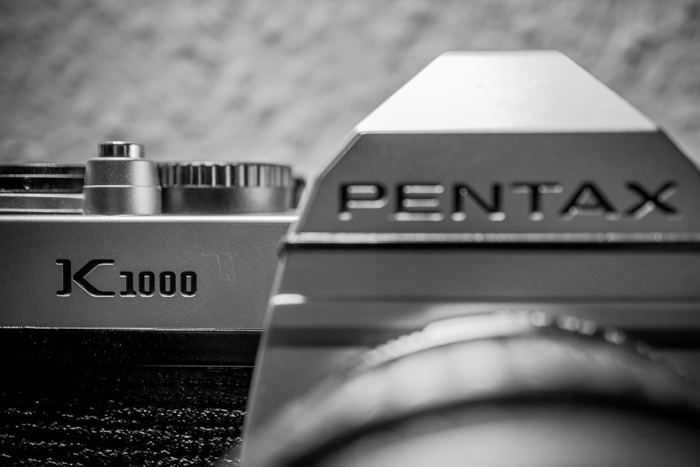
[Annotation: This was on the higher cease of the price range I found, but information technology had detailed pictures of the item and descriptions written by someone who conspicuously knew their stuff. I also found a lot of bodies without lenses for considerably less.]
I went with the Pentax K1000 because they relish a great reputation on cyberspace forums. Lauded for being dependable workhorses, they're incredibly basic in their feature set up and are entirely mechanical.
They do take a pocket-sized button bombardment to run the integrated light meter, but the battery is not required to operate the camera. The runners up were an Olympus OM-10, Nikon F3, and Canon AE-i.
A lens
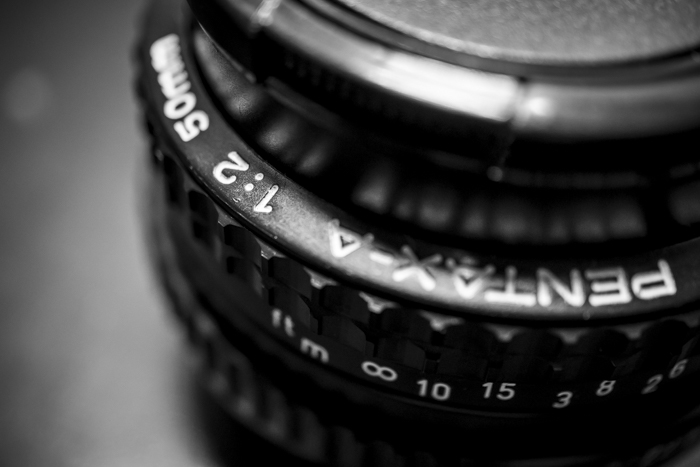
My K1000 came with a 50mm lens, simply if you decide to buy your trunk and lens a la bill of fare, brand sure the lens is uniform with your body. If you're not able to inspect the lens in person, make double-sure.
(A few keywords you want to await for in eBay listings are "no fungus or mold," "no oil on aperture blades," and specially, "no scratches.")
Your kickoff ringlet of movie
Every bit far every bit actual film stock, I really wanted to exercise black and white. There is just something about old-time black and white prints that depict me in.
I read equally much as I could, and eventually decided to purchase some Kodak Tri-X and Ilford HP5 (yous tin can get this on Amazon or B&H in the US, or MacoDirect if you're in Europe).
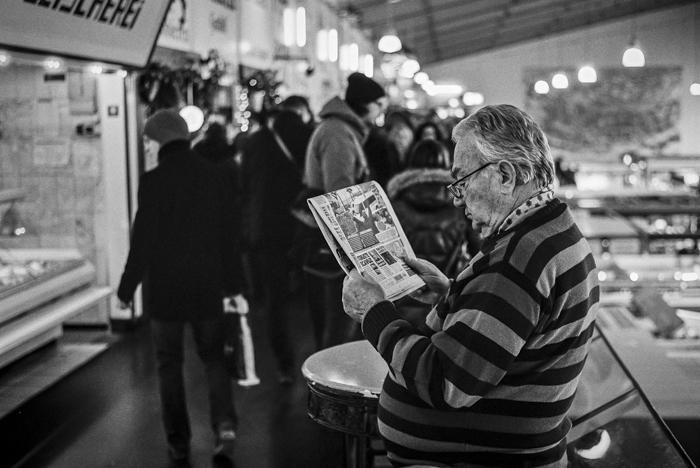
Ilford HP5 400
These two brands are in current production, and most moving-picture show labs know how to develop them in standard processes (read: I didn't want my outset gyre to become destroyed at Walmart because information technology was some goofy express run with specific evolution instructions).
Boilerplate price/coil is around $five as of the time of this writing. I figured I'd shoot a coil or two of both and see which prints I liked meliorate. (Spoiler: The HP5 won for greater tonal range and a softer contrast, but that's some other article.)
If you're more than interested in colour film, yous tin notice Fuji Superia in Walmarts, Walgreens, and CVS across the Us. Average price at the time of publishing is about $2.50/roll, with higher ISOs being slightly more expensive.
An excellent selection for accurate skin tones is Kodak's Portra 400, but it's pricier and yous'll need to order it online or at a specialty camera store.
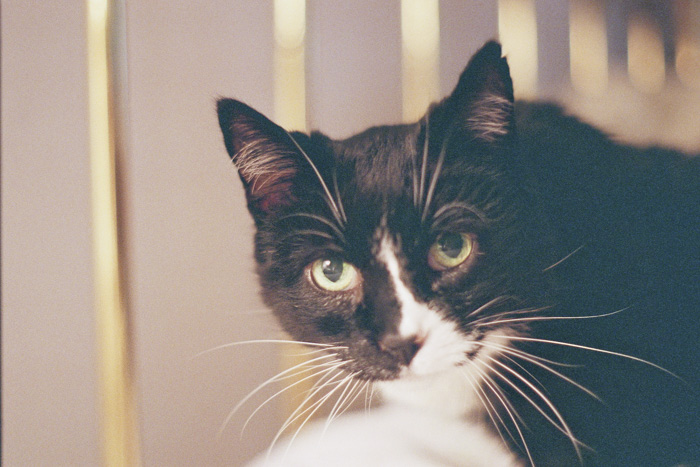
My mom's true cat. Information technology's not a fantastic shot from a technical standpoint, but it shows my photographic camera has no light leaks.
Notation: I would strongly recommend running an cheap roll through your new camera trunk merely to run across if at that place are any light leaks or sticky shutter issues. There is no betoken going hog-wild buying upwards film if your camera is going to destroy every roll.
Somewhere to develop and/or browse your film
I realized that my previous feel with moving-picture show consisted of "take it to Walgreens and come up back in a few days to get the pictures." That was an assumption that remained unchanged since my grade-school years.
I had do some serious YouTube crash courses to acquire what all developing entailed. After I did that, I realized that the beginning few rolls I shot would be developed by someone else, in a professional person lab.
Once your negatives are developed, you can optionally take them scanned or become prints made. I again realized that operating my own scanner and making certain that all my negatives were dust-free was far too time-consuming. I decided to have the same lab that developed my negatives browse them for me besides.
Let'south tally up our kit so far:
Pentax K1000 w/ 50mm f/two lens: $80.00
Roll of Ilford HP5 (36 exposures): $5.29
Evolution and scanning at a local film lab: $14.00
Full: $99.29
As you lot can see, this comes in right nether $100! Then there yous take it — you've just shot and adult a roll of film, and have digital scans to share on social media. What comes next? Well, that'due south up to y'all.
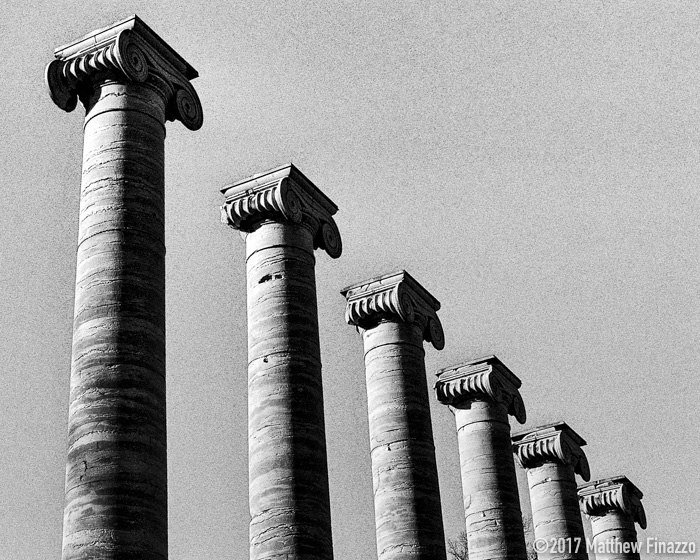
The columns at the University of Missouri. Kodak Tri-X 400, scanned to TIFF and edited in Lightroom CC.
You might decide that shooting film is too much trouble or that development and printing costs too much or that it'south the greatest thing ever.My only request would be to make voodoo dolls of Mike instead of me if you find you're spending all your Starbucks money (ok, fine, beer money) on rolls of film. This is his blog, later on all. ;)
In a future commodity, I'll discuss in greater detail what to practice with all your moving-picture show once you've shot and developed it. I'll besides show you some additional accessories for your new film kit that have the potential to really permit your inventiveness run wild!
Helpful Resources: Old Schoolhouse Color Lightroom presets
If you aren't quite prepare to build a film camera simply yet want to get the interesting colors that come up from colour moving-picture show photography in your digital photography, check out the Hacking Photography Old School Colors Lightroom presets.
These presets were created to try and simulate the nice soft colors and tones that film produced.
Click the prototype beneath to see more than examples of how they piece of work.
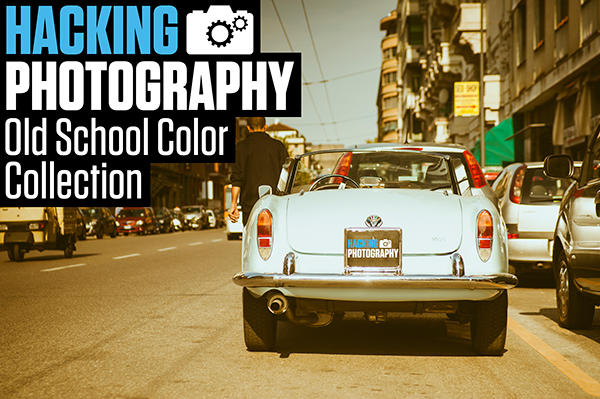
Source: https://www.hackingphotography.com/how-to-build-a-film-camera-for-less-than-100/
Posted by: davisalowely.blogspot.com

0 Response to "How To Make Your Own Film Camera"
Post a Comment